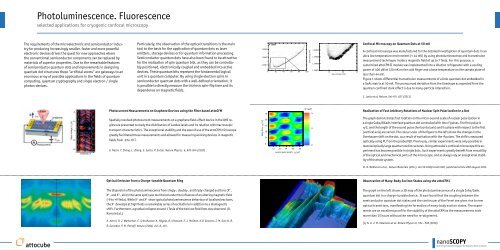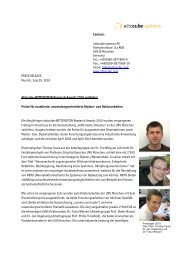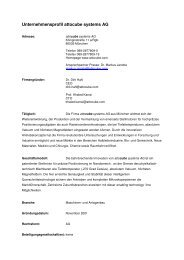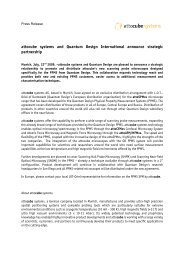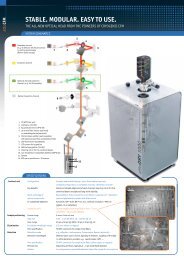nanoscopy - attocube
nanoscopy - attocube
nanoscopy - attocube
You also want an ePaper? Increase the reach of your titles
YUMPU automatically turns print PDFs into web optimized ePapers that Google loves.
Photoluminescence. Fluorescence<br />
selected applications for cryogenic confocal microscopy<br />
The requirements of the microelectronic and semiconductor industry<br />
for producing increasingly smaller, faster and more powerful<br />
electronic devices drives the quest for new approaches where<br />
the conventional semiconductor components can be replaced by<br />
materials of superior properties. Due to the remarkable features<br />
of semiconductor quantum dots and improvements in designing<br />
quantum dot structures these “artificial atoms” are gateways to an<br />
enormous array of possible applications in the fields of quantum<br />
computing, quantum cryptography and single electron / single<br />
photon devices.<br />
pioneers of precision<br />
Particularly, the observation of the optical transitions is the main<br />
tool to the basis for the application of quantum dots as laser<br />
emitters, storage devices or for quantum information processing.<br />
Semiconductor quantum dots have also been found to be attractive<br />
for the realization of spin quantum bits, as they can be controllably<br />
positioned, electronically coupled and embedded into active<br />
devices. These quantum bits represent the fundamental logical<br />
unit in a quantum computer. By using single electron spins in<br />
semiconductor quantum dots with a well-defined orientation, it<br />
is possible to directly measure the intrinsic spin-flip time and its<br />
dependence on magnetic fields.<br />
Photocurrent Measurements on Graphene Devices using the Fiber based attoCFM<br />
Spatially resolved photocurrent measurements on a graphene field-effect device in the QHE regime<br />
are presented to study the distribution of Landau levels and its relation with macroscopic<br />
transport characteristics. The exceptional stability and the ease of use of the attoCFM microscope<br />
greatly facilitated these measurements and allowed for measuring working devices in magnetic<br />
fields from -9 to +9 T.<br />
G. Nazin, Y. Zhang, L. Zhang, E. Sutter, P. Sutter, Nature Physics, 6, 870–874 (2010) .<br />
Optical Emission from a Charge-tunable Quantum Ring<br />
The dispersion of the photoluminescence from singly-, doubly-, and triply-charged excitons (X 1- ,<br />
X 2- , and X 3- , all on the same spot) was monitored under the influence of an altering magnetic field<br />
(-9 to +9 Tesla). While X 1- and X 2- show typical photoluminescence behaviour of localized excitons,<br />
the X 3- develops at high fields a remarkable series of oscillations in addition to a diamagnetic<br />
shift. Furthermore, a gradual collapse around 1 Tesla of the two low field lines was observed. (K.<br />
Karrai et al.)<br />
K. Karrai, R. J. Warburton, C. Schulhauser, A. Högele, B. Urbaszek, E. J. McGhee, A.O. Govorov, J. M. Garcia, B.<br />
D. Gerardot, P. M. Petroff, Nature (2004) 247, 8, 135.<br />
laser energy (eV)<br />
laser energy (eV)<br />
1.2983 1.2983<br />
1.2982<br />
1.2981 1.2981<br />
1.29812<br />
1.29810<br />
1.29808<br />
1.29806<br />
1.29804<br />
delay time, τd [ns]<br />
70<br />
56<br />
42<br />
28<br />
14<br />
0<br />
X 1- 50mK<br />
0 20 40 60 80 100<br />
gate voltage (mV)<br />
15 30 45<br />
gate voltage (mV)<br />
∆E [µeV]<br />
13 26 39 52 65<br />
second pulse length, τp [µs]<br />
"<br />
laser energy (eV)<br />
laser energy (eV)<br />
50432G/26<br />
50433G/26<br />
50434G/26<br />
50435G/26<br />
50436G/26<br />
50437G/26<br />
50438G/26<br />
50439G/26<br />
5043:G/26<br />
5043:G/26<br />
5043;G/26<br />
50442G/26<br />
50443G/26<br />
50444G/26<br />
50445G/26<br />
50446G/26<br />
50447G/26<br />
50448G/26<br />
50449G/26<br />
5044:G/26<br />
5044;G/26<br />
50452G/26<br />
50453G/26<br />
50454G/26<br />
50455G/26<br />
50456G/26<br />
50456G/26<br />
50457G/26<br />
50458G/26<br />
50459G/26<br />
5045:G/26<br />
5045;G/26<br />
50462G/26<br />
50463G/26<br />
50464G/26<br />
50465G/26<br />
50466G/26<br />
50467G/26<br />
50468G/26<br />
50469G/26<br />
5046:G/26<br />
5046;G/26<br />
50472G/26<br />
50472G/26<br />
50473G/26<br />
50474G/26<br />
50475G/26<br />
50476G/26<br />
50477G/26<br />
50478G/26<br />
50479G/26<br />
5047:G/26<br />
5047;G/26<br />
50482G/26<br />
50483G/26<br />
50484G/26<br />
50485G/26<br />
50486G/26<br />
50487G/26<br />
50488G/26<br />
50488G/26<br />
50489G/26<br />
5048:G/26<br />
5048;G/26<br />
50492G/26<br />
50493G/26<br />
50494G/26<br />
50495G/26<br />
50496G/26<br />
50497G/26<br />
50498G/26<br />
50499G/26<br />
5049:G/26<br />
5049;G/26<br />
504:2G/26<br />
504:3G/26<br />
504:4G/26<br />
504:4G/26<br />
504:5G/26<br />
504:6G/26<br />
504:7G/26<br />
504:8G/26<br />
504:9G/26<br />
504::G/26<br />
504:;G/26<br />
504;2G/26<br />
504;3G/26<br />
504;4G/26<br />
504;5G/26<br />
504;6G/26<br />
504;7G/26<br />
504;8G/26<br />
504;9G/26<br />
504;:G/26<br />
504;:G/26<br />
504;;G/26<br />
50522G/26<br />
50523G/26<br />
50524G/26<br />
50525G/26<br />
50526G/26<br />
50527G/26<br />
50528G/26<br />
50529G/26<br />
5052:G/26<br />
5052;G/26<br />
50532G/26<br />
50533G/26<br />
50534G/26<br />
50535G/26<br />
50536G/26<br />
50536G/26<br />
50537G/26<br />
50538G/26<br />
50539G/26<br />
5053:G/26<br />
5053;G/26<br />
50542G/26<br />
50543G/26<br />
50544G/26<br />
50545G/26<br />
50546G/26<br />
50547G/26<br />
50548G/26<br />
50549G/26<br />
5054:G/26<br />
5054;G/26<br />
50552G/26<br />
0<br />
1.29808 1.29808<br />
1.29806 1.29806<br />
1.29804<br />
-6<br />
1.2983<br />
1.2982<br />
1.2981<br />
1.29810 1.29810<br />
laser energy (eV)<br />
1.29812<br />
X 1- 50mK<br />
0 20 40 60 80 100<br />
gate voltage (mV)<br />
15 30 45<br />
gate voltage (mV)<br />
gate voltage (mV)<br />
Confocal Microscopy on Quantum Dots at 50 mK<br />
A confocal microscope was manufactured for the detailed investigation of quantum dots in an<br />
ultra low temperature environment (< 44 mK) by using photoluminescence and transmission<br />
measurement techniques inside a magnetic field of up to 7 Tesla. For this purpose, a<br />
customized attoCFM II module was implemented into a dilution refrigerator with a cooling<br />
power of 400 μW at 120 mK on the cold finger and a base temperature on the sample plate of<br />
less than 44 mK.<br />
Figure 1 shows differential transmission measurements of a InAs quantum dot embedded in<br />
a GaAs matrix at 50 mK. The pronounced deviation from the lineshape as expected from the<br />
quantum confined stark effect is due to many-particle interaction.<br />
C. Latta et al, Nature, Vol 474, 627 (2011)<br />
Realization of Fast Arbitrary Rotations of Nuclear Spin Polarization in a Dot<br />
The graph demonstrates fast rotation on the micro-second scale of nuclear polarization in<br />
a single GaAs/AlGaAs interface quantum dot controlled with two rf pulses. The first pulse is<br />
π/2, and the length of the second pulse (horizontal axis) and its phase with respect to the first<br />
(vertical axis) are varied. The colour scale of the figure to the left shows the changes in the<br />
Overhauser shift on the dot, as a result of excitation with the rf pulses. The shift is measured<br />
optically using PL from the probed QD. Previously, similar experiments were only possible in<br />
macroscopically large quantum well structures. Using <strong>attocube</strong>’s confocal microscope this experiment<br />
has become possible in single dots. Such experiments greatly benefit from versatility<br />
of the optical and mechanical parts of the microscope, and as always rely on exceptional stability<br />
of the whole system.<br />
M. N. Makhonin et al., Nature Materials (2011), doi:10.1038/nmat3102, published online 28th August 2011.<br />
Observation of Many-Body Exciton States using the attoCFM I<br />
The graph on the left shows a 3D map of the photoluminescence of a single InAs/GaAs<br />
quantum dot in a charge-tunable device. It was found that the coupling between the<br />
semiconductor quantum dot states and the continuum of the Fermi sea gives rise to new<br />
optical transitions, manifesting the formation of many-body exciton states. The experiments<br />
are an excellent proof for the stability of the attoCFM as the measurements took<br />
more than 15 hours without the need for re-alignment.<br />
[1] N. A. J. M. Kleemans et al. Nature Physics 6, 534 - 538 (2010).<br />
nanoSCOPY<br />
Scanning Probe Microscopes for Extreme Environments


